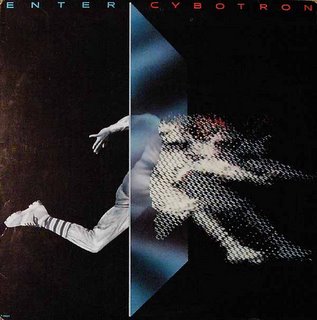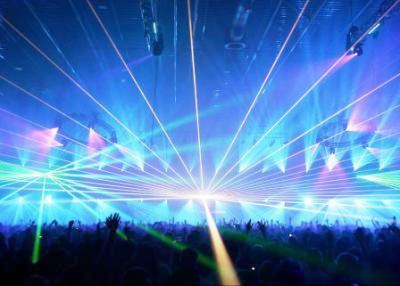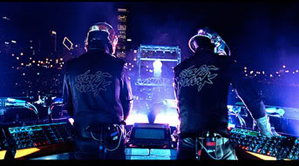Electronic Music is an umbrella term encompassing numerous genres. Electronic music employs the use of electronic instruments and/or electronic technology for musical production. This would include everything from the telharmonium of the Wild West, to Jimi Hendrix’s guitar amplifier, and Daft Punk’s Jazz Mutant Lemur touchpad. The use of electronic technology in musical production did not begin until the 1970’s. Parliament Funkadelic employed a heavier use of the synthesizer and music technology with a blues and rock sound during the late 1970’s. Parliament Funkadelic incorporated themes of futurism and science fiction into their performance through the use of lights, sound effects, and space-like outfits. Soon following Parliament Funkadelic, the 1980’s brought about more developments in the use of synthesizers and drum machines. Such developments in music technology brought the birth of what we know today as electronica. This term includes genres such as techno, dance, house, funk, synthpop, experimental, electro, trance, ambient, and numerous other genres.
Most genres encompassed by electronica were commonly derived from the percussive drumbeats of electro music. Electro music was first pioneered in Detroit by multiple artists, most notably Cybotron. Frontman Juan Atkins based his music on the futurist ideology that places artistic value to noises not normally considered musical. These noises would include anything outside of the conventional scalar structure of musical timbres. In other words, electro music attempted to discover the musicality in noises that would never have thought to be musical. Many styles soon branched out from this futurist pretense.
The heavy use of synthesizers, drum machines, awkward time signatures, controlled distortion, and robotic vocals emphasize the  genre’s science fiction and futuristic influences. Artists focused on producing sounds that had never been heard. With the use of various light effects, smoke machines, and even space-like costumes, dance parties in Detroit’s underground became truly otherworldly. Every facet of the performance was geared towards provoking emotions and sensations never experienced before through conventional music. During the fleeting moment of a performance, audience and musicians alike were taken to the future. genre’s science fiction and futuristic influences. Artists focused on producing sounds that had never been heard. With the use of various light effects, smoke machines, and even space-like costumes, dance parties in Detroit’s underground became truly otherworldly. Every facet of the performance was geared towards provoking emotions and sensations never experienced before through conventional music. During the fleeting moment of a performance, audience and musicians alike were taken to the future.
The influence of electronic music soon jumped to Europe where it  further matured. At the same time, Detroit’s influence reached the East Coast where the use of music technology would be further redefined. In the projects of Brooklyn, the Bronx, and Queens, the art of sampling (taking a portion of one sound recording and reusing it as an instrumental entity) would take a complete turnaround. From funky electro and early techno came the culture of Hip Hop. Through the genius of artists such as Afrika Bambaataa and Grandmaster Flash came a whole new way of life. further matured. At the same time, Detroit’s influence reached the East Coast where the use of music technology would be further redefined. In the projects of Brooklyn, the Bronx, and Queens, the art of sampling (taking a portion of one sound recording and reusing it as an instrumental entity) would take a complete turnaround. From funky electro and early techno came the culture of Hip Hop. Through the genius of artists such as Afrika Bambaataa and Grandmaster Flash came a whole new way of life.
Golden Age Hip Hop artists like Grandmaster Flash and Afrika Bambaataa harnessed  skills of Detroit based techno and produced electronic music primarily based off of samples of other works. They pioneered methods such as cutting, back-spinning, and phasing to add an unheard level of performance to their equipment and song production. Not only did they sample from song, television, and radio recordings but altered the samples both sonically and rhythmically to generate completely different productions from their original counterparts. Hip Hop producers often partner their songs with the rhythmic delivery of poetry known as rap. During the Golden Age (early 1980’s to mid 1990’s) topics emcees would deliver pertained to the current social norms of the time. In a sense, emcees made sociological reports whenever they took the stage. By pairing a rhythmic social commentary of the present with the revolutionary and futuristic sounds of hip hop production, the listener was taken to a different time and age while reminiscently looking back at how things are. skills of Detroit based techno and produced electronic music primarily based off of samples of other works. They pioneered methods such as cutting, back-spinning, and phasing to add an unheard level of performance to their equipment and song production. Not only did they sample from song, television, and radio recordings but altered the samples both sonically and rhythmically to generate completely different productions from their original counterparts. Hip Hop producers often partner their songs with the rhythmic delivery of poetry known as rap. During the Golden Age (early 1980’s to mid 1990’s) topics emcees would deliver pertained to the current social norms of the time. In a sense, emcees made sociological reports whenever they took the stage. By pairing a rhythmic social commentary of the present with the revolutionary and futuristic sounds of hip hop production, the listener was taken to a different time and age while reminiscently looking back at how things are.
Science fiction’s prevalence in music is obvious. It is tragic that the correlation between the two has not been examined as much as it should at the scholarly level. Electronica and Hip Hop are still not generally recognized as established genres of music while science fiction is still disputed as a reputable form of literature. Although this is the case, the trend is moving towards a greater study of the relationship between the two.
|

